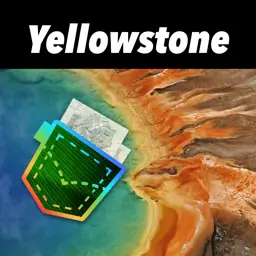"Grand Teton, Moose Entrance" by U.S. National Park Service , public domain
Disappearing GlaciersNature |
Disappearing Glaciers brochure for Grand Teton National Park (NP) in Wyoming. Published by the National Park Service (NPS).
featured in
| National Parks Pocket Maps |  | |
| Idaho Pocket Maps |  | |
| Wyoming Pocket Maps |  | |
| Yellowstone Pocket Maps |  |
Grand Teton
National Park Service
U.S. Department of the Interior
Grand Teton National Park
John D. Rockefeller, Jr.
Memorial Parkway
Disappearing Glaciers
Middle Teton Glacier. NPS Photo.
Glaciers
A glacier is a river of ice flowing slowly downhill due to gravity. Ice slides over
bedrock eroding the surface below, and deforming under its own weight. If the
ice quits moving, the remaining snow and ice become a permanent snowfield or
remnant glacier.
An active glacier is a balance between winter snow accumulation and summer
melt. If accumulation outpaces melt for a number of years, the glacier will advance.
If the reverse is true, the glacier will retreat, meaning the toe will melt back faster
than the glacier is flowing.
Importance
Modern Glaciers
Crevasses on Middle Teton
Glacier. NPS Photo.
Timing
Glaciers respond to climate trends providing a
visual and measurable record of change—glaciers
advance with cooling temperatures and retreat
with warming. Currently, meltwater from the
glaciers provides an important late-season water
source, and a year-round source of cold water key
for native aquatic species. As glaciers disappear,
this important water source will disappear.
There are up to eleven glaciers in the park today.
Ten glaciers named on area maps include Teton,
Middle Teton, Teepe, Schoolroom, Petersen,
Skillet, Falling Ice and Triple. Scientists recently
identified another unnamed glacier below Glacier
Peak bringing the total to eleven. Some of these
glaciers may no longer be moving and are now
remnant glaciers.
a Snickers bar slowly. The brittle chocolate
fractures while the caramel and nougat bends.
Measuring glacier movement is difficult, but
crevasses can indicate that ice is likely moving.
Crevasses form when the brittle upper layer of the
glacier cracks as the more ductile ice beneath flows
over obstacles or around corners. Imagine bending
The park’s modern glaciers are not remnants of
the larger Pleistocene Ice Age glaciers that shaped
the Teton Range’s canyons and valley-floor lakes.
Those glaciers disappeared by 10,000 years ago.
In addition to ecological benefits, glaciers are also
an iconic part of the Teton landscape providing
aesthetic and recreational value. Imagine Mount
Moran no longer flanked by five glaciers—the
Skillet Glacier gone forever.
Glaciers flow, on average, inches to feet per day.
Smaller glaciers with flatter surfaces, like the ones
in the park, move slowly—probably less than a
few inches per day in the summer. In winter, the
ice freezes to the bedrock so glacial flow ceases.
Studies from the 1960s and 70s measured Teton
Glacier flowing about 30 feet (9.1 meters) per
year—averaging a few inches (<10 cm) per day
during the summer.
Instead, current glaciers developed during a
recent cold period known as the Little Ice Age that
lasted from about 1300 to 1850.
Ice Thickness
Glacial ice flows over uneven bedrock. Even with
surface data, estimating ice thickness is difficult.
Researchers can use ground-penetrating radar to
calculate ice thickness, but these surveys are costly
and time-intensive.
Retreat & Disappearance
When Fritiof Fryxell first surveyed the park’s
glaciers in the late 1920s, the ice was already
retreating. The terminal moraines he mapped
marked the 1850 glacial maxima of the Little Ice
Age. Even though the glaciers are retreating, there
have been a few brief glacial advances in 1975–83
and 2006–09. Some people in the late 1970s feared
another ice age!
The park’s glaciers likely range from less than one
hundred to a few hundred feet thick. The only
known field measurement of ice thickness was
done in 1966, and the Teton Glacier was 64 feet
(19.5 meters) thick near its terminus.
Methods to track glacial retreat include measuring
decreases in the length of the glacier, surface area
and ice volume. One study of the Teton Glacier
measured 104 feet (32 meters) of retreat from
1954 to 1994. Another study from the late 1980s
estimated 600 feet (183 meters) of retreat and 160
200 feet (49-61 meters) of thinning since 1929.
The park’s glaciers are small but they do vary in
size, shape, aspect and slope making predictions of
their disappearance difficult. The smallest glaciers,
such as Teepe Glacier, have likely stopped moving
and may disappear within decades. Larger glaciers,
such as the Teton and Middle Teton glaciers, may
last for more than one hundred years. Ongoing
studies of ice volume change will quantify how
quickly glaciers are melting.
On-going Studies
Researchers are currently measuring ice loss and
mapping surface changes for several park glaciers.
Park GIS staff teamed with the Jenny Lake
climbing rangers to collect hundreds of GPS data
points to generate a map of a glacier’s surface.
Annual surveys will allow scientists to determine
how much ice volume is lost and changes to the
glacier’s surface. The team surveyed Schoolroom
Glacier in 2014, and Middle Teton Glacier in 2015
and 2016 with plans to continue.
Jenny Lake climbing rangers and park GIS staff measure
GPS points on the surface of Middle Teton Glacier. NPS
Photo/M. Tyson.
Climate Change
The Teton Glacier moraine, visible as the sharp-crested
ridge, marks the glacier’s maximum extent during the
Little Ice Age. More recent ice terminus positions are
noted. Reproduced with permission from Creation of
the Teton Landscape.
Daily images from time-lapse cameras provide
records of snow pack and ice melt in a safe and
time-effective manner. Currently, Teton, Middle
Teton, Falling Ice and Petersen glaciers have
cameras, with the possibility of expansion to cover
more glaciers.
Glaciers respond in large
part to winter precipitation
adding new snow and ice,
and summer heat melting
snow and ice. Yearly
weather varies greatly, but
climate change models
predict increased rainfall
and decreased snowfall at
a given elevation in winter
and warmer temperatures
in summer. The models
indicate glaciers will
retreat. Climate began
1700 years of global temperature change. Before 1850, temperature estimates
from proxy data. After 1850, thermometer-based data. NOAA Climate.gov
warming after 1850
but accelerated due to
increased levels of greenhouse gases since the start of the Industrial Revolution. In
short, human-caused climate change has greatly accelerated the glacial retreat.




